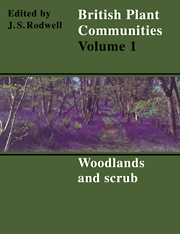Book contents
- Frontmatter
- Contents
- List of Figures
- Foreword
- Preface and Acknowledgements
- Preamble
- General Introduction
- Woodlands and Scrub
- Introduction to Woodlands and Scrub
- Key To Woodlands and Scrub
- Community Descriptions
- W1 Salix Cinerea-Galium Palustre woodland
- W2 Salix Cinerea-Betula Pubescens-Phragmites Australis Woodland
- W3 Salix Pentandra-Carex Rostrata Woodland
- W4 Betula Pubescens-Molinia Caerulea Woodland
- W5 Alnus Glutinosa-Carex Paniculata Woodland
- W6 Alnus Glutinosa-Urtica Jzozca Woodland
- W7 Ainus Glutinosa-Fraxinus Excelsior-Lysimachia Nemorum Woodland
- W8 Fraxinus Excelsior-Acer Campestre-Mercurialis Perennis Woodland
- W9 Fraxinus Excelsior-Sorbus Aucuparia-Mercurialis Perennis Woodland
- W10 Quereus Robur-Pteridium Aquilinum-Rubus Fruticosus Woodland
- W11 Quereus Petraea-Betula Pubescens-Oxalis Acetosella Woodland
- W12 Fagus Sylvatica-Mercurialis Perennis Woodland
- W13 Taxus Baccata Woodland
- W14 Fagus Sylvatica-Rubus Fruticosus Woodland
- W15 Fagus Sylvatica-Deschampsia Flexuosa Woodland
- W16 Quereus spp.-Betula spp.-Deschampsia Flexuosa Woodland
- W17 Quereus Petraea-Betula Pubescens-Dicranum Majus Woodland
- W18 Pinus Sylvestris-Hylocomium Splendens Woodland
- W19 Juniperus Communis Ssp. Communis-Oxalis Acetosella Woodland
- W20 Salix Lapponum-Luzula Sylvatica Scrub
- W21 Crataegus monogyna-Hedera helix scrub
- W22 Prunus Spinosa-Rubus Fruticosus Scrub
- W23 Ulex Europaeus-Rubus Fruticosus Scrub
- W24 Rubus Fruticosus-Holcus Lanatus Underscrub
- W25 Pteridium Aquilinum-Rubus Fruticosus Underscrub
- Index of Synonyms to Woodlands and Scrub
- Index of Species in Woodlands and Scrub
- Bibliography
W14 - Fagus Sylvatica-Rubus Fruticosus Woodland
Published online by Cambridge University Press: 04 July 2020
- Frontmatter
- Contents
- List of Figures
- Foreword
- Preface and Acknowledgements
- Preamble
- General Introduction
- Woodlands and Scrub
- Introduction to Woodlands and Scrub
- Key To Woodlands and Scrub
- Community Descriptions
- W1 Salix Cinerea-Galium Palustre woodland
- W2 Salix Cinerea-Betula Pubescens-Phragmites Australis Woodland
- W3 Salix Pentandra-Carex Rostrata Woodland
- W4 Betula Pubescens-Molinia Caerulea Woodland
- W5 Alnus Glutinosa-Carex Paniculata Woodland
- W6 Alnus Glutinosa-Urtica Jzozca Woodland
- W7 Ainus Glutinosa-Fraxinus Excelsior-Lysimachia Nemorum Woodland
- W8 Fraxinus Excelsior-Acer Campestre-Mercurialis Perennis Woodland
- W9 Fraxinus Excelsior-Sorbus Aucuparia-Mercurialis Perennis Woodland
- W10 Quereus Robur-Pteridium Aquilinum-Rubus Fruticosus Woodland
- W11 Quereus Petraea-Betula Pubescens-Oxalis Acetosella Woodland
- W12 Fagus Sylvatica-Mercurialis Perennis Woodland
- W13 Taxus Baccata Woodland
- W14 Fagus Sylvatica-Rubus Fruticosus Woodland
- W15 Fagus Sylvatica-Deschampsia Flexuosa Woodland
- W16 Quereus spp.-Betula spp.-Deschampsia Flexuosa Woodland
- W17 Quereus Petraea-Betula Pubescens-Dicranum Majus Woodland
- W18 Pinus Sylvestris-Hylocomium Splendens Woodland
- W19 Juniperus Communis Ssp. Communis-Oxalis Acetosella Woodland
- W20 Salix Lapponum-Luzula Sylvatica Scrub
- W21 Crataegus monogyna-Hedera helix scrub
- W22 Prunus Spinosa-Rubus Fruticosus Scrub
- W23 Ulex Europaeus-Rubus Fruticosus Scrub
- W24 Rubus Fruticosus-Holcus Lanatus Underscrub
- W25 Pteridium Aquilinum-Rubus Fruticosus Underscrub
- Index of Synonyms to Woodlands and Scrub
- Index of Species in Woodlands and Scrub
- Bibliography
Summary
Synonymy
Beechwood association Moss et al. 1910p.p.; Fagetum sylvaticae plateau beech woods Adamson 1922 p.p.; Beech associes, seres 1 & 2 Watt 1924; Chalk plateau beechwoods (b) Watt & Tansley 1930; Beech associes, seres A p.p. & B Watt 1934b; Beech consociation, seres 1 & 2 Watt 1934b; Beech consociation, seres A p.p. & B Watt 1934b; Fagetum rubosum Tansley 1939 p.p.; Beech-Oak-Ash Association, types 3 & 7 McNeill 1961; Beech-oak-holly woods Peterken & Tubbs 1965 p.p.; Cotswold beechwoods Barkham & Norris 1967 p.p.; Beechwood Rackham 1980p.p.; Beech stand type 8D Peterken 1981; Woodland plot types 17 & 20 Bunce 1982.
Constant species
Fagus sylvatica, Ilex aquifolium, Rubus fruticosus agg.
Rare species
Epipactis purpurata.
Physiognomy
The Fagus sylvatica-Rubus fruticosus woodland is a floristically simple community organised on a very large scale. Typically, in mature stands, the canopy is overwhelmingly dominated by Fagus sylvatica which forms a closed, even-topped cover of trees that can attain a magnificent stature. It is in this community that beech makes its best general height growth in Britain with individuals commonly attaining 30 m or more and yielding timber of the top-quality classes (e.g. Watt 1934/?, Brown 1953, McNeill 1961). Where the trees are well spaced, tall and unbranched below, they give the canopy an architectural quality, creating the impression of a vast, spacious vault. Even here, however, growth is frequently not so good as this, varying considerably, even on the most favourable soils, with exposure, and becoming distinctly poorer where edaphic conditions are not so congenial (Watt 1934/?, Brown 1953, 1964). Moreover, stands often have a greater measure of structural complexity related to patterns of natural invasion or treatment or both. In younger, sub-spontaneous woodlands of this kind, the height and density of the beech can be much less uniform, and it is sometimes possible to distinguish older, more richly branched pioneers that led the colonisation of open ground from subsequent generations of straighter, more crowded trees that followed (Watt 1924, 1934/?). Even in more long-established stands, grouped age-classes and physiognomic variation may give some clues to the history of the vegetation, as Peterken & Tubbs (1965) demonstrated in the New Forest (see also Tubbs 1968). Many tracts of the community show signs of treatment. Some have obviously been planted, with regularly-disposed, morphologically-similar and even-aged trees giving the canopy great structural uniformity.
- Type
- Chapter
- Information
- British Plant Communities , pp. 241 - 250Publisher: Cambridge University PressPrint publication year: 1991

